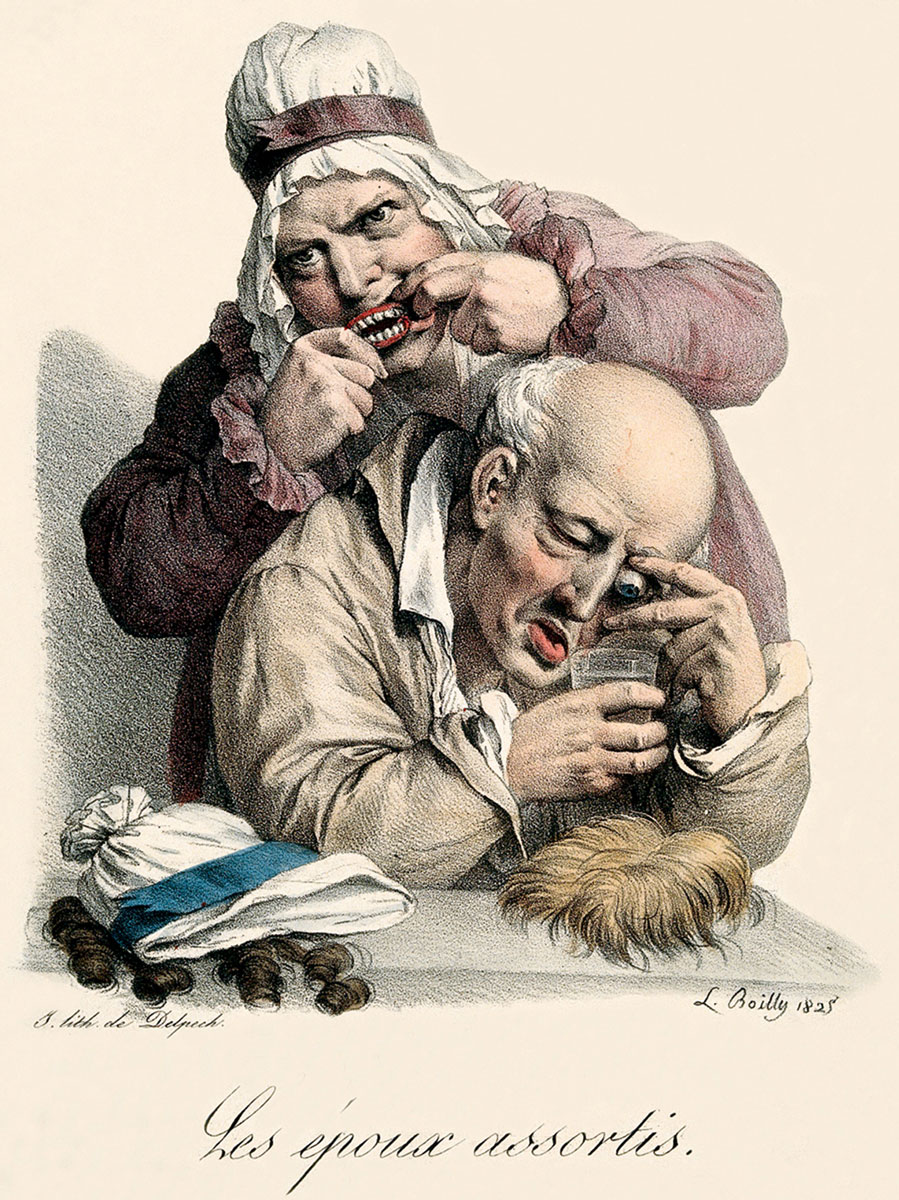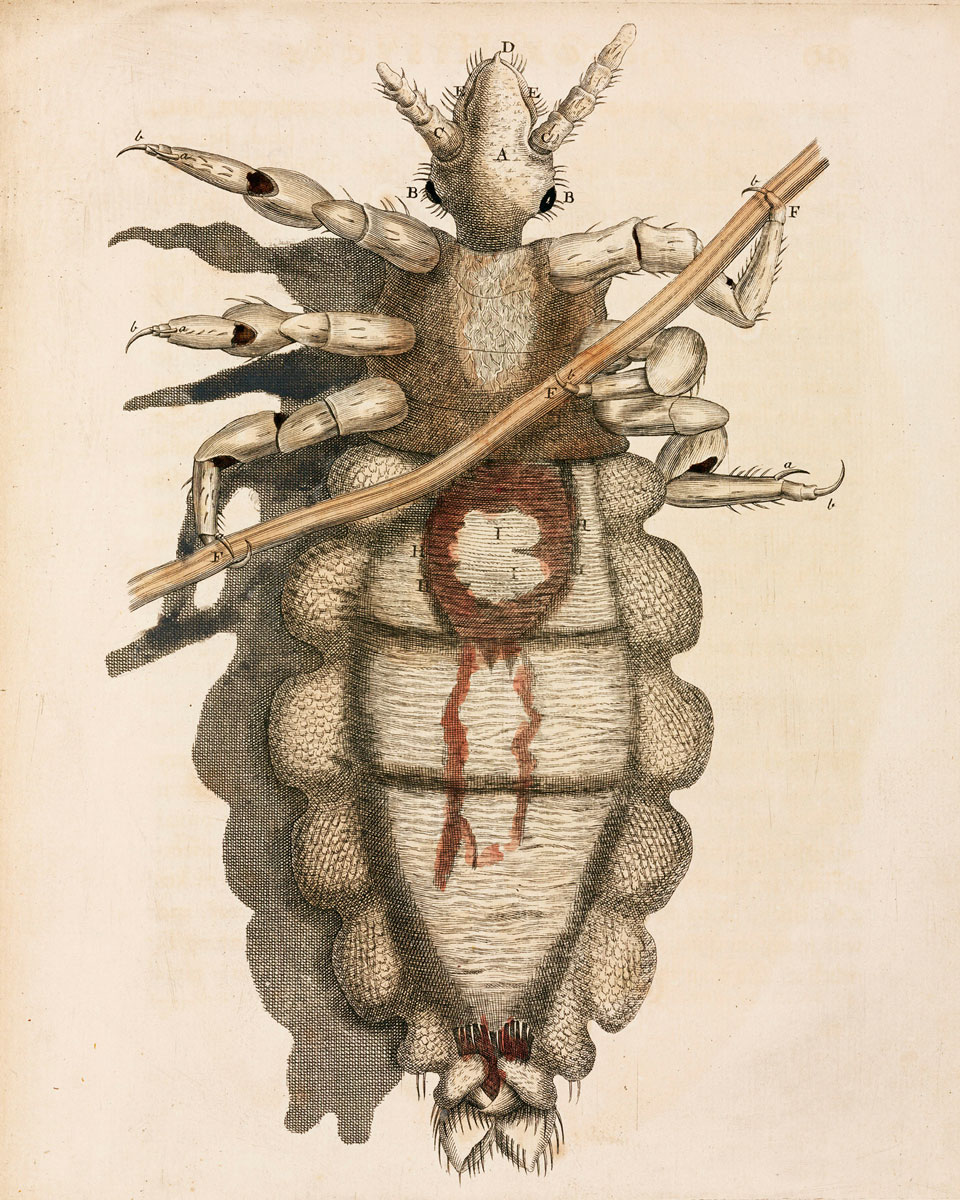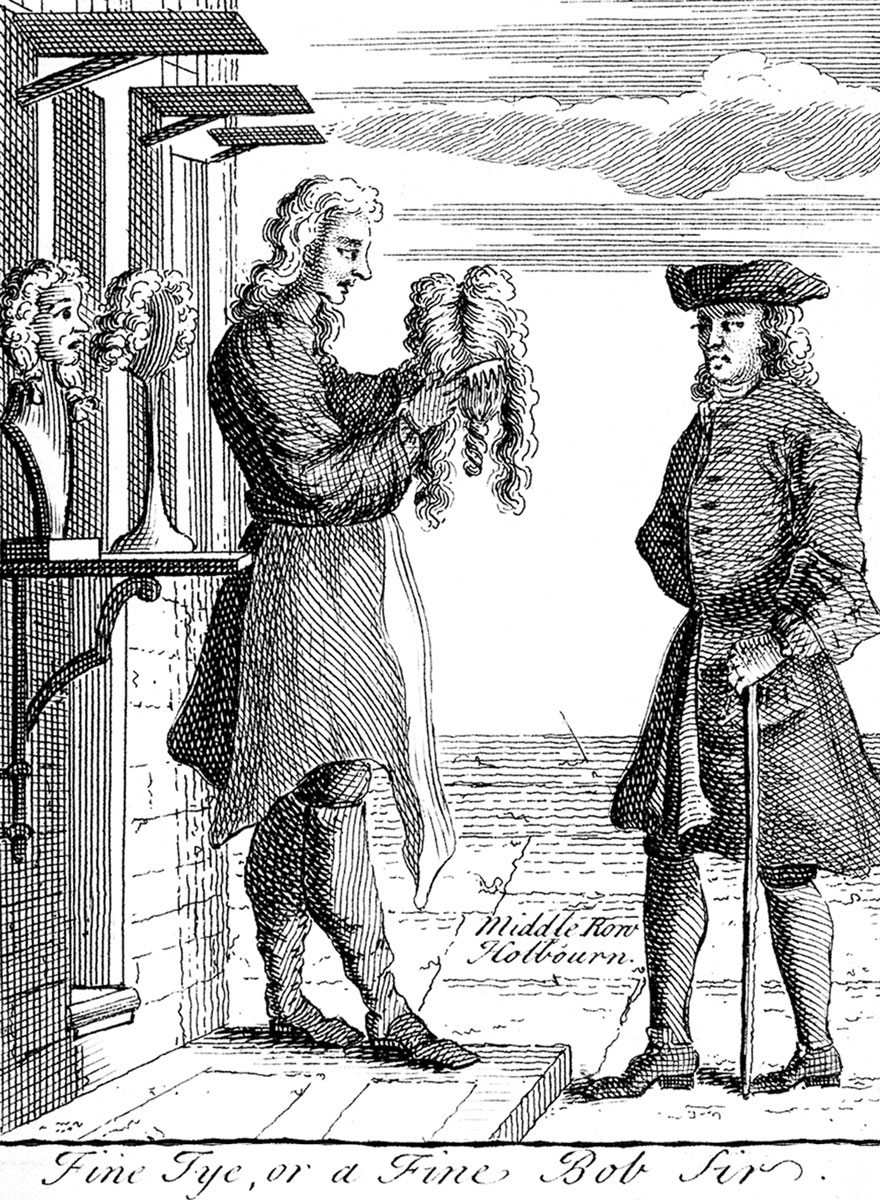Matters of the Head
Hair and wigs in eighteenth-century England
Emma Markiewicz
In an account of his visit to England in 1748, the Swedish botanist Pehr Kalm reports that “Farm-servants, clodhoppers, day-labourers, Farmers, in a word, all labouring-folk go through their usual every-day duties with all Peruques on the head. Few, yea, very few, were those who only wore their own hair.”[1] Accustomed as we are to a range of Hollywood images of bewigged aristocrats, we might be surprised by the widespread use of wigs in eighteenth-century England, but abundant visual and documentary evidence confirms that Kalm’s observation was not anomalous. In fact, the wig was a ubiquitous part of life across the social spectrum in England in the first half of the eighteenth century until it began to fall out of fashion, and its connection to a range of social concerns provides new insight into the era’s conceptions of health, hygiene, beauty, and status.

Debates about contagion and the spread of infection in published medical works frequently referenced hair, and the hair used in wigs, as a concern. Work by seventeenth-century physicians such as Thomas Sydenham had shown that emanations from the earth—from human, animal, or inanimate matter—were contributors common to the spread of all disease. As such ideas took hold, hair, fur, and even silk or feathers came under suspicion. Derived from living creatures, these materials were believed to still contain “animal juices” and to “receive and communicate infection.”[5] Unsurprisingly, during a time when the plague seemed ever-imminent, there was considerable anxiety that the hair used to make wigs may have been contagious. Stories about wigs infected with plague and smallpox travelling the country were repeated anecdotally, with one writer claiming that a wig had passed on infection from London to Plymouth. In the 1660s, Samuel Pepys voiced similar concerns, writing: “Up, and put on my … new periwigg, bought a good while since, but darst not wear it because the plague was in Westminster when I bought it.”[6] This anxiety was found not only among physicians, hair merchants, and those living in busy, dirty cities, but also in the trade laws of the day. A Parliamentary bill from the late 1740s specifically referred to human hair as “more especially liable to retain infection, and may be brought from Places infected into other countries, and from thence imported into his Majesty’s Dominions.”[7] It was recommended that hair being brought into Britain should be subject to an order of quarantine. Likewise John Brooks, a wigmaker who also traded hair, submitted a memo to the Treasury in 1756 stating that he would like to inspect “humane and brute hair” being brought into the country for “plague and any other Contagious Distemper whatever.”[8]
Some physicians questioned the reality of the problem, however, wondering why doctors’ medical wigs were not responsible for a great deal more spreading of infection than was believed to be the case. Richard Mead (1673–1754), a physician who made a study of transmissible disease, was also less inclined to blame the doctor’s wig for the spread of infection, setting out a theory that certain “plague keepers” could only transmit the disease if the air was bad at the same time.[9]
It was not uncommon for hairdressers to publish their own manuals on caring for and dressing the hair; in addition to containing useful information for clients on the importance of keeping their hair clean, these often also served the additional function of advertising products and services. Rather than undergoing a continuous process of shedding and renewal, as we understand today, hair was believed to accrue strength, which it sustained into maturity. As a result, hairdressers argued it was worth investing in the health of one’s hair from a young age.
The complicated and expensive hairstyles sported by many fashionable women during the eighteenth century meant that they were unlikely to comb their hair, sometimes leaving it untouched for months, leading one commentator to wonder if they had to apply mercury in order to keep away lice, the scourge of all social classes in this period. Already in his 1665 book Micrographia, Robert Hooke (1635–1703) had made some detailed and radical observations about lice using microscopic lenses. Hooke’s examination had shown that a louse was able to cling on to an individual hair using its claws, which enabled it to feed from blood vessels in the scalp.[10] A century before Hooke, when a humoral understanding of the body was unchallenged, nits had been seen as an unavoidable aspect of daily life, with hygienists attributing them to the excess of humors and uncontrolled substances emanating from within the body. Hooke’s work with the microscope was groundbreaking as it showed that lice “proceed from [the eggs of] parents of their own kind, and not (as formerly was supposed) from certain juices or humours of human bodies.”[11]This new understanding suggested that individuals could affect whether they were infested with lice, and that they could control the presence of nits by maintaining certain levels of external cleanliness in their hair, skin, and clothes. Lice, of course, were perfectly visible without the use of a microscope, much to the disgust of Pepys, who in 1667 describes refusing a wig from his barber, as it was “full of nits.”[12]
Pepys’s disgust highlights the changing attitudes to cleanliness apparent towards the end of the seventeenth century. By the time he was writing, the notion that dirt could be controlled externally meant that it had become a social concept, not just an internal, corporeal one. Thus the greater importance given to the appearance of cleanliness, and the demonization of dirt as a threat to decency and order.[13] This shift in attitude is one prominent factor in the increasing popularity of wigs, as the need to crop or shave the head in order to accommodate a wig helped reduce the likelihood of lice infestation, not to mention the fact that hairdressers could clean false hair with greater ease and regularity.

For many people in the eighteenth century, a look of youthful beauty was only available for a fleeting period. City dwelling, harsh physical work, a propensity for diseases which left permanent physical scarring, and simply growing old all made the image of attractive health nearly impossible for the majority of working people to maintain. But this was not simply an issue of class. People situated in higher socio-economic groups, such as the independently wealthy or those in professions affording a more genteel lifestyle, were also at risk of disfiguring diseases, to say nothing of obesity and problems with joints and movement that resulted from overindulging in life’s pleasures.
Then, as now, it was common to employ artifice to maintain socially mandated aesthetic standards. Using cosmetics to hide imperfections on the face, powders and dyes to disguise the graying color of hair, and stays and underclothes to change the silhouette were all popular tactics. Of course, wig wearing was a crucial part of this regimen. In one case, a man was observed to tie a thick tape in the back of his wig, pulling it tightly to compress his temples and face, thus giving himself an instant face-lift and reducing the appearance of sagging skin.[14] A similar technique that involved tying a ribbon under the arms and hiding it with a wig could correct bad posture in children.[15] In addition to projecting an image of a healthy body, wigs could disguise an unhealthy one, covering scars from medical procedures, hiding disfigurements, or camouflaging physiological defects requiring medical intervention such as a hearing aid.[16] Wigs could likewise be used to protect a wound after an operation, or to prevent an abscess or ulcer from making contact with the air.[17]

Customs records detail the “hair humane” that was brought into London ports, imported in the largest quantities from Flanders, France, Holland, and Spain (to the value of approximately £33,500 in today’s money from Spain alone in one month during 1726).[19] It arrived in lesser quantities from Italy, Portugal, and “East Country,” along with horsehair from Russia. There is no record of hair being exported in its raw form, but quantities of perukes were sent to Germany, Russia, Turkey, and England’s overseas territories (Barbados, Jamaica, New England, New York, Carolina, and the West Indies).[20]
Judging from period documents, trading in hair had the potential to be the most lucrative area of the business. In 1756, John Brooks of Holborn recorded sales of parcels of French hair worth £90,000 (roughly £6.5 million today).[21] Harvey Spragge, recorded as a “Hair and Silk Merchant,” was said to have died leaving a fortune of £30,000 in 1733.[22] At the other end of the social spectrum were itinerant chapmen, who often sold human hair, particularly in the late seventeenth and early eighteenth centuries at the height of the wig’s popularity. Urban hair merchants are known to have employed dealers to purchase hair from around the country and it is possible that some exploited the chapmen’s communication links. Another way to procure hair was to make it come to you, as can be seen from advertisements placed by barbers and wig-makers with offers such as this: “If any man or woman hath good hair to sell, let them repair to George Gray Barber and Perriwig maker over against the Greyhound Tavern in Blackfriars, London; there they shall have at least as much ready money as anybody else will give.”[23]
Hair merchants were also often responsible for the sorting, dyeing, and curling of the hair prior to selling it to barbers and wigmakers. This breadth of work meant that these businessmen were often the largest employers in the entire industry and maintained the widest trading networks. The larger merchants also employed “pickers” to sort through the hair and select the best quality hanks, arranging them into colors and winding them onto rollers for curling. For the latter work, many merchants maintained connections with bakers who would bake it for a nominal fee. Of course, some merchants were wholesalers who sold the hair untreated, suggesting a certain crossover in which wigmakers, barbers, and merchants could all be responsible for undertaking the preparation of the raw material. This would have made it harder for the customer to be sure of the quality or provenance of the product, making the wigmaker’s relationship with the customer of paramount importance to economic survival.
A clean, well-appointed shop would have been particularly vital for those engaged in the hair trade in order to attract customers, particularly in an urban environment where competition was high. House visits were also common, with practitioners splitting their time according to demand—typically spending three days in the shop and three days making visits. In many larger towns, different occupations had their own districts, which the wealthy and fashion-conscious would have been familiar with and visited to acquire various goods. In London, wigmakers often set up shop in the West End and the Strand, situated in what was already an important area for textiles and clothing, as well as an entertainment district where members of high society would gather to see and be seen.
The idea generally accepted by fashion historians is that the wig came to England from France in the second half of the seventeenth century through the court of Charles II. Large, bell-bottomed wigs, which were hugely expensive items using enormous amounts of hair, were certainly popular at court and among the upper classes, setting off as they did a rich, grand, and dignified silhouette when paired with embroidered coats, long waistcoats, and lace ruffles. But despite these lofty origins, an extensive network of hair practitioners did develop to supply the lower classes with cheaper forms of wigs. In 1727, Daniel Defoe asserted that there were thirty thousand barbers and wigmakers in London alone.[24] This figure is almost certainly a deliberate exaggeration—especially considering that estimates in the 1750s suggest the total population of the city was approximately eighty-seven thousand—but the exaggeration does dramatize how this strange prosthetic, which Defoe observes was “little known” in England fifty years before, came to be a ubiquitous fixture on the heads of both aristocrats and commoners.
- Pehr Kalm, Kalm’s Account Of His Visit to England On His Way To America in 1748 (London: Macmillan and Co.,1892), p. 52.
- Aristotle (pseud.), Aristotle’s New Book of Problems, Set Forth by Question and Answer, sixth edition (London: John Marshall, 1725), p. 32.
- Ibid., p. 80.
- Alexander Stewart, The Natural Production of Hair or its Growth and Decay, Being a Great and Correct Assistance to its Duration (London: self-published, 1795), p. 5.
- Richard Mead, A Short Discourse Concerning Pestilential Contagion, and the Methods to be Used to Prevent It (London: no publisher given, 1720), p. 77.
- Latham, ed., The Diary of Samuel Pepys (London: Bell and Hyman, 1985), p. 520.
- British Parliamentary Papers, 1747, vol. 9, “A Bill to Oblige Ships more Effectually to Perform their Quarentine; and for the better Preventing the Plague being brought from Foreign Parts into Great Britain, or Ireland, or the Isles of Guernsey, Jersey, Alderney, Sark, or Man.”
- The National Archives, T1/370/27, “The Humble Memorial of John Brooks Peruke Maker and Dealer in Hair and Corn” (1756).
- Richard Mead, Some Remarks on Three Treatises of the Plague (London: Sam Buckley & Ralph Smith, 1721), p. 20.
- Hooke, Micrographia (London: The Royal Society, 1665), p. 64.
- Ibid.
- Latham (ed.), Diary of Samuel Pepys, op. cit., p. 746.
- Georges Vigarello, Concepts of Cleanliness (Cambridge: Cambridge University Press, 1988) p. 79.
- William Rowley, The Rational Practice of Physic (London: no publisher given, 1793), p. 358.
- Andry De Bois-Regard, Orthopaedia: or the Art of Correcting and Preventing Deformities in Children (London: A. Millar, 1743), p. 95.
- Lorenz Heister, A General System of Surgery in 3 Parts (London: no publisher given, 1743), p. 435.
- Richard Wiseman, Eight Chirurgical Treatises, on these Following Heads (London: Benjamin Tooke and John Meredith, 1705), p. 433; Pierre Dionis, A Course of Chircugical Operations Demonstrated in the Royal Gardens at Paris (London: Jacob Tonson, 1719), p. 458; Charles Gabriel Le Clerc, The Compleat Surgeon: or the Whole Art of Surgery Explained, fifth edition (London: R. Bonwicke et al., 1714), p. 36.
- Anonymous, Some Considerations on the Present State of the Hair Trade (London: no publisher given, 1730)
- This figure was derived using the National Archives currency converter, avilable at www.nationalarchives.gov.uk/currency.
- The National Archives, CUST 3/ 28A, 1726.
- The National Archives, T1/370/27, 1756.
- St. James Evening Post (London), no. 2752, (16 January 1733).
- Intelligencer Published for the Satisfaction and Information of the People (London), no. 13 (February 1665).
- Daniel Defoe, The Compleat English Tradesman, vol. 2 (London: Charles Rivington, 1727), p. 167.
Emma Markiewicz works at the National Archives in London. She is currently completing a PhD dissertation titled “Hair, Wigs, and Wig Wearing in Eighteenth-Century England” at the University of Warwick.